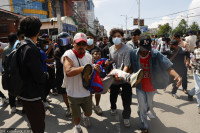Editorial
For a refreshing ride
We must set up infrastructures and amenities to take care of drivers’ wellbeing to ensure road safety.
Our roads are becoming increasingly unsafe due to poor and haphazard construction, natural disasters. But more often than not, it is because our drivers are overworked, and there is hardly any solid monitoring mechanism in place to check their physical and mental status. Providing resting time for drivers becomes even more crucial during monsoons, when landslides obstruct roads and the journeys become longer.
Realising the need to provide drivers with resting time and place, the Lumbini Province Government started building five “smart refresh centres” in Bardaghat in Nawalparasi West, Sainamaina in Rupandehi, Chandrauta in Kapilvastu, Lamahi in Dang, and Bardiya along the East-West Highway four years ago. These centres promise washrooms, eateries, restrooms, shower rooms, charging stations, parking area, among other amenities, to help drivers and passengers tackle fatigue during long-distance travels. However, due to budget constraints, the project hasn’t seen the light of day yet.
While the idea of starting the refresh centres is laudable, there is a clear lack of coordination among political parties to complete the project. The ambitious project took shape in Lumbini during the CPN-UML government when it set aside around Rs110 million. But the government was ousted even as it began construction work, and the new government, led by the Maiosts, slashed the budget for the project. The project got shelved by subsequent governments. Even though the first phase of the project (only the construction of the building) has been completed in Sainamaina, its operation has been halted as it lacks proper guidelines for functioning. The experiment in Lumbini has been a failed project.
Nepal’s Motor Vehicle and Transport Management Act mandates drivers to rest after six hours of driving. However, the authorities have failed to enforce the rules, let alone arrange proper rest areas for the drivers. Safer roads not only improve road safety but also help the country's tourism flourish. As we strive to expand our tourism agenda by attracting more tourists, the importance of ensuring basic resting facilities along the highways cannot be overstated. Providing the best services for tourists will attract them to the country, thereby boosting our economy and buttressing international reputation.
While it is encouraging that several other provinces have rest centres along highways, the conditions are far from decent. Most of these centres lack basic sanitary and hygiene services. Moreover, such small projects lack sufficient construction as well as maintenance funds, as has been the case in Lumbini. The governments’ tendency to consider them “trivial” is equally concerning. Such a mindset not only hinders our journey towards making roads safer but also other opportunities that come along with it, including tourism promotion and passenger satisfaction.
As highway accidents become a regular phenomenon in Nepal, we need more smart refresh centres. The federal government should therefore come on board and help provincial and local governments construct these centres through enough budget allocation on need basis. It is also necessary to devise a plan to maintain and renovate existing ones that lack enough amenities for drivers and passengers. Meanwhile, political parties should heed the projects that are in the best interests of people, and not weigh them on the basis of whether they fall under their party’s priority or not.




 11.12°C Kathmandu
11.12°C Kathmandu














